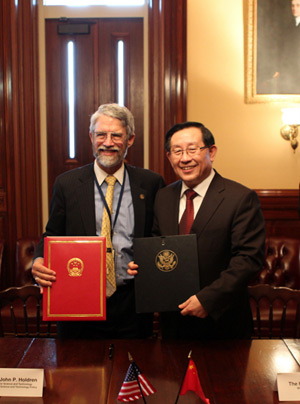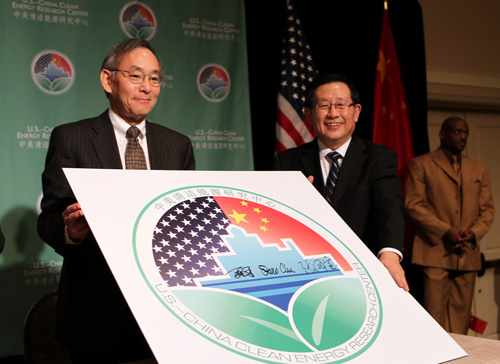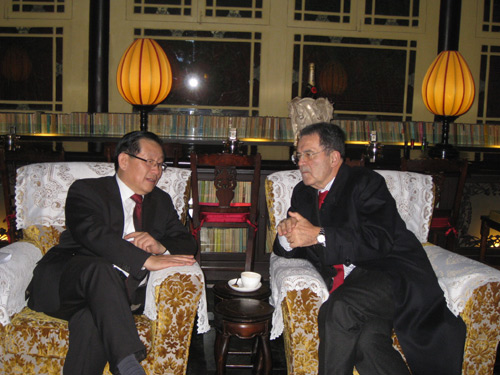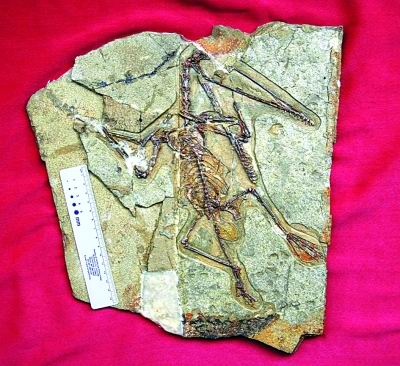CHINA SCIENCE AND TECHNOLOGY
NEWSLETTER
The Ministry of Science and Technology
People's Republic of China
|
|
|
N0.608 |
January 30, 2011 |
|
|
|
|
|
|
|
|
IN THIS ISSUE
|
|
*Top Ten Domestic Popular Science Events
* Top Ten TCM News Events
*Pragmatic Clean Energy Cooperation
*China-US S&T Protocol Renewed
*China-US Clean Energy Center Inaugurated
* WAN Met with Italian Guests
* Chinese Made 40n Mobile Chips
* Fossilized Dinosaur’s Gender Identified
|
Top Ten Domestic Popular Science Events
China’s top ten popular science events in 2010, voted by some academicians of the Chinese Academy of Sciences and the Chinese Academy of Engineering, and by experts from popular science communities and scientific news media under the sponsorship of China Association for Science and Technology, were unveiled on Jan. 26, 2011. They are:
1. Chinese President HU Jintao and other Party and state leaders visited China Science and Technology Museum, attending the event of "experiencing science, and enjoying a happy growth" together with Chinese and foreign children;
2. A six-episode TV series "QIAN Xusen" made a hit. Scientists’ biography has for the first time become a theme in major documentary films or TV feature programs in the country;
3. "Low carbon" becomes a catchword in the year, implying enhanced popular awareness of energy efficiency and emission reduction;
4. Shanghai World Expo was held on the theme of "changing urban life through science and technology”, allowing people to enjoy the accomplishments of S&T development;
5. Successful launch of Chang'e 2, a lunar probe satellite. The live broadcast of the launch event made more people aware of space activities;
6. ZHANG Wuben, a fake nutritionist, lost his aura. Keeping fit in a scientific manner becomes a focus of mass media;
7. Zhouqu landslides and Shanghai high-rise fires show people’s poor awareness of public safety. Dealing with emergencies in a scientific manner draws people’s attention;
8. Genetically modified food became controversial again, and people became more concerned with the safety of genetically modified foods;
9. Sci-fi blockbuster "2012" made a hit. People are more concerned with the future of both Earth and humans;
10. An exceptional annular eclipse that may appear once every 1,000 years triggered up astronomical observation fever.
Top Ten TCM News Events
State Administration of Chinese Traditional Medicine unveiled on Jan. 24, 2011 the top ten news events on traditional Chinese medicine in 2010. They are:
1. Traditional Chinese medicine becomes part of the Medicare reform, and has achieved positive results in implementation. Local governments raised the reimbursement proportion of traditional Chinese medicine, and lowered down the threshold for the payment. Meanwhile, efforts have been made to promote the use and stock of basic traditional Chinese medicines;
2. Chinese acupuncture becomes part of the intangible cultural heritage. "Compendium of Materia Medica" and "Yellow Emperor's Classic of Internal Medicine", two ancient Chinese medical books, were selected as part of the Memory of the World (Asia-Pacific);
3. A Confucius Traditional Chinese Medicine Institute was jointly founded by Nanjing University of Traditional Chinese Medicine and the Australian Royal Melbourne Institute of Technology, in an attempt to open up a new window for foreigners to understand traditional Chinese medicine and Chinese culture;
4. International Organization for Standardization (ISO) made Shanghai the home of the Secretariat of TCM Technical Committee, and convened the first committee meeting;
5. Traditional Chinese medicine was applied in treating the patients in major natural disasters, including the one occurred in Yushu and Zhouqu;
6. China has for the first time made a nationwide survey on traditional Chinese medicine, which improved people’s knowledge of the basic status of traditional Chinese medicine;
7. Traditional Chinese Medicine in China Action shifted its focus to the rural areas, neighborhood communities, and families, guiding people to have a sound knowledge of Chinese medicine and associated application;
8. Four government agencies released the "near term work plan for traditional medicines”, in an effort to enhance the support to traditional medicines;
9. Modern traditional Chinese medicine becomes a part of emerging bio-medicines under the nation’s strategic development plan. Meanwhile, Danshen dripping pill, a Chinese medicine compound, has completed the phase II clinical trials sponsored by the United States FDA, and will soon enter phase III trials.
10. Five TCM projects won 2nd place prize of the National Science and Technology Progress Award.
|
INTERNATIONAL COOPERATION |
Pragmatic Clean Energy Cooperation
Chinese and American participants who attended the Second US-China Clean Energy Cooperation Forum said on Jan. 18, 2011 that both China and the United States are facing an array of challenges in the areas of energy security and climate change, and that both sides should work together to address the challenges in the area of new energy.
Speaking at the forum, WAN Gang, Chinese Minister of Science and Technology, pointed out that a range of challenges, including climate change, energy/resources security, and food security, are becoming increasingly prominent. No countries in the world can be immune to the challenges. We should work together to advocate clean energy, freeing ourselves from the dependence on fossil fuel energy, through scientific and technological innovations, promoting the transition from fossil fuel energy to clean energy. WAN added that in the last couple of years, China and the U.S. have made new progresses in clean energy cooperation, thanks to the concerted efforts of governments, industrial communities, universities, and research institutes in the two countries. China and the United States should enhance cooperation in the area of clean energy technology, achieving mutually benefited and win-win results, making new contributions to the welfare of the two peoples.
China-US S&T Protocol Renewed

A signing ceremony was held on January 19, 2011 at the White House to renew a bilateral science and technology cooperation protocol between China and the United States. WAN Gang, Vice-Chairman of Chinese People’s Political Consultative Conference and Minister of Science and Technology, and Dr. John P. Holdren, Director of the White House Office of Science and Technology Policy inked an accord to renew the protocol on behalf of the two governments.
The scientific and technological cooperation protocol is the first bilateral accord signed between the two governments. The protocol is supposed to be renewed every five years. A joint committee meeting is sponsored every two years by Chinese or the United States Government in an alternate manner. Both sides agreed that the 14th China-US Science and Technology Cooperation Joint Committee meeting will take place in October 2011 in China.
China-US Clean Energy Center Inaugurated


An inauguration ceremony was held on January 18, 2011 in Washington to put a China-US Clean Energy Research Center into operation. WAN Gang, Chinese Minister of Science and Technology, Steven Chu, the United States Energy Secretary, and ZHANG Guobao, Chinese National Energy Administrator unveiled the name plate at the inauguration.
WAN Met with Italian Guests

WAN Gang, Chinese Minister of Science and Technology, met on January 16, 2011 with the visiting former Italian Prime Minister Romano Prodi in Beijing. WAN thanked Prodi for the important contributions he has made to promoting the cooperation between China and Italy. He recalled the efforts made by Prodi in promoting the development of the Italian Institute of Tongji University when he was in office as Prime Minister. WAN also briefed his Italian guests of China’s national science and technology planning system and associated development. He said China’s high-tech R&D and industrialization parks have played an important role in the nation’s economic and social development. Chinese government will enhance the cooperation between China and Italy through establishing a number of joint ventures, including China-Italy technology transfer center, China-Italy creative design center, and China-Italy e-government center. Prodi thought highly of the scientific and technological developments in China, believing that enhanced collaborations in the area of science and technology is in the common interests of both countries.
China-US Optical Network Test Lab
Not long ago, an optical network test laboratory, jointly established by Beijing University of Posts and Telecommunications (BUPT) and JDSU, was officially inaugurated. JDSU shared with BUPT advanced high-speed optical communication test platforms and solutions.
Both sides are optimistic about the business perspective of high-speed transmission technology at the level of 100G or higher. BUPT is currently working on the transmission technology heading for the level of 100G or higher. JI Yuefeng, Director of BUPT Institute of Photonics and Optical Communications said at the inauguration ceremony that one has to work hard to tackle the key technologies that will establish a high-speed transmission network at the level of 100G or higher. The Institute has been granted with government support for developing advanced modulation, reception, and transmission technologies. The efforts have not only resulted in technological innovations, but also brought out talented people who are good at such innovation. He expects more collaboration with JDSU in the area of ultra-high speed optical fiber communication, especially joint tests. JDSU provides the lab the measuring instruments needed for field network tests at different stages.
Home Made Superconducting Tapes
It took three years for LI Yijie and his team at Shanghai Jiaotong University Dept. of Physics to master the technology to manufacture second-generation superconducting tapes at a hundred meter level, a new breakthrough in home made superconducting tapes.
The superconducting tape is literally a thin film with a metal base 1cm wide and 80 microns thick. The rare earth oxide tape designed to transmit superconducting current is less than 1 micron in thickness. Comparing to traditional copper wires, the superconducting tape enjoys a current carrying capacity several hundred times the copper wires.
The second-generation superconducting tape has registered a current carrying capacity of 194 amps at a hundred meter level. Thanks to repeated experiments and tests, researchers have found solutions to securing the stability, repeatability, and reliability of the coating process that has to be addressed in future commercial applications.
Chinese Made 40n Mobile Chips
Spreadtrum Communications made the debut of a 40-nanometer mobile chip that becomes commercially available for the first time in the world. The multi-mode handsets equipped with the chip have passed the network access and storage tests required by the Chinese telecommunications authority and China Mobile, fully up to the criteria for commercial applications. A number of domestic vendors, including Beijing Tianyu Communication Equipment and Qingdao Hisense Communication, have sent their orders for the chip, and are planning to work on TD mobile phones using the chip. YANG Wenlin, Qingdao Hisense general manager, said the introduction of 40-nanometer mobile chip will reduce the terminal price of TD-SCDMA, making TD mobile phones more competitive in the future.
Fossilized Dinosaur’s Gender Identified

"Mrs T", with a wing span of 0.78m, is preserved with an egg.

Reconstructed images of Darwinopterus: the female without crest (left), and the male with crest (Mark Witton).
A study, led by LÜ Junchang, a research fellow at Chinese Academy of Geological Sciences Institute of Geology in Beijing, in collaboration with scientists of Zhejiang Museum of Natural History in Hangzhou and University of Leiceste, has recently discovered a female individual of Darwinopterus preserved together with an egg from the Jurassic of China, providing a direct evidence of gender in pterosaurs and insights into the reproductive biology of these extinct fliers. The finding was published in the January 23, 2011 issue of the journal Science.
The fossilized pterosaur (known as "Mrs T" by researchers) was found without crest, and kept with an egg, indicating that a female pterosaur was born without crest. Researchers also found that it has a relatively large “belt”, or the pelvis, to hold the fallopian tubes. Researchers believe that males of this pterosaur had a relatively small pelvis and a large cranial crest, whereas females had a relatively large pelvis without crest.
Map World
A Map World, built by the State Bureau of Surveying and Mapping, was put into operation online on January 18, 2011. Map World is designed to provide authoritative, credible, and unified online map services to the public. As an important part of "Digital China", it is the most comprehensive geographic information and data resources in the country.
Min Yiren, Deputy Director-General of the State Bureau of Surveying and Mapping, told reporters that Map World is an internet-based geographic information service network, made up of massive basic geographic information up to 30TB, with 3 billion electronic map tiles, including: 1:1,000,000 worldwide vector topographic data and satellite images in 250m resolution, 1:250,000 nationwide public map data, electronic navigation map data, satellite images in 15m resolution, satellite images in 2.5 m resolution, remote sensing images in 0.6 m resolution for 319 cities at the prefectural level, and 10 cities at the country level, and three-dimensional street data of some cities.
Map World can be viewed and searched in two-dimensional or three-dimensional manner, for place names, location, distance, and area measurement, along with a range of functions, including points of interest marking, driving route planning, names switch in both English and Chinese, and screen shots/printing. The website provides 24-hour "one-stop" map service either in the form of portal or service interface.
China’s Internet Status Report
China Internet Network Information Center (CNNIC) released on May 19, 2011 in Beijing its 27th statistical report on China’s internet development. The Report shows that as of the end of December 2010, China had an internet user population of 457 million, or 7.33 million up compared with the end of 2009. Online shoppers hit a most noticeable and fastest growth by 48.6%.
Meanwhile, the internet penetration rate rose to 34.3%, or 5.4% up compared with 2009. China has registered a mobile phone user population up to 303 million, with an increase of 6,930 people compared with the end of 2009. Mobile phone netizens enjoyed a raised proportion in the total netizen population, from 60.8% at the end of late 2009 to 66.2%. Internet users access to internet through diverse means, with laptop enjoying the largest growth. Report also shows that in 2010, Chinese netizens who access internet using desktop, mobile phone, and laptop reached 78.4%, 66.2% and 45.7% respectively.
The Report shows that 92.7% of small and medium-sized enterprises have secured an internet access, with large enterprises at 100%. 43% of Chinese businesses have their own websites, or have opened shops on e-commerce platforms. 57.2% of enterprises communicate with customers via internet, providing consultation to them. 42.1% of small and medium-sized enterprises had an e-commerce platform or online marketing application. 21.3% of them admitted that e-mail makes the most popular approach for internet based marketing.
Comments or inquiries on editorial matters or Newsletter content should be directed to:
Department of International Cooperation, MOST 15B, Fuxing Road, Beijing 100862, PR China Tel: (8610)58881360 Fax: (8610) 58881364
http://www.most.gov.cn

